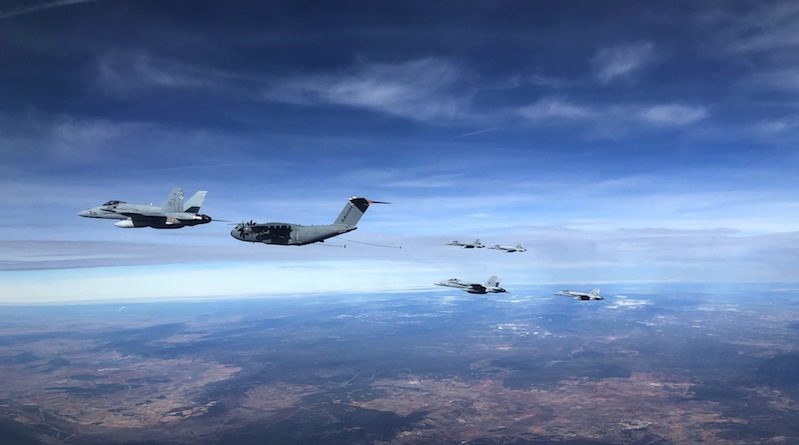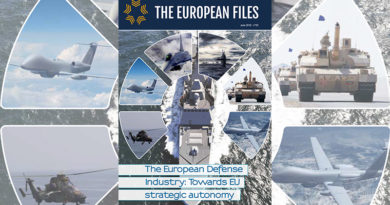
Innovation and competitiveness in the European defence sector
European leaders realise that providing European security is best done together as individual Member States cannot handle today’s security threats on their own. Lack of cooperation between Member States in the security and research domain is estimated to cost between €25 – 100 billion a year.
Here, the United States have a considerable advantage. For example, the three European fighter aircraft Eurofighter, Gripen and Rafale cost €30 billion to develop, compared to €19 billion for development of the US-led F-35 Joint Strike Fighter.
Given the expected worldwide sales, developing the three European aircraft costs more than 4 times as much as the US solution per unit sold.
In the defence industry, the trend is towards competition between fewer, larger and global players.
If European industry wants to compete globally, it must pool and integrate its industrial and technological talents and resources.
The European defence industry has historically been rather innovative, with many military applications, such as radar, entering civilian markets.
But reductions in military research and development investment, combined with the long service life of military equipment, make the defence innovation cycles slower compared to civilian ones.
It is clear that defence remains the sole responsibility of the Member States. This is not in contradiction with saying that more could be achieved together than alone.
In 2016, European leaders asked the EU to lay the foundations for a stronger European defence policy. The Commission was asked to propose ways to enhance European defence cooperation and boost the competitiveness of Europe’s defence industry.
Less than one year later, the European Defence Fund was launched, aiming to help boost the EU’s excellence and efficiency by funding cooperative defence-oriented research and development projects and facilitating the joint acquisition of military equipment by Member States.
By spending together, EU countries can spend smarter, increase efficiency and eliminate unnecessary duplication in defence spending.
Change won’t come easily. The defence sector is highly conservative and risk averse. Industry seeks to reduce the financial risk associated with a highly regulated market which is usually limited to one customer the Ministry of Defence.
They won’t develop new products or services if they are not sure they will be able to sell them. And the customers are conservative too they tend to fund only projects that comply with their own national requirements.
Both sides see risk in change. We aim to facilitate a win-win situation for both industry and the Member States to join forces at the EU level by creating the framework to make cooperation attractive.
Member States remain in the driver’s seat, agreeing on common priorities of capabilities to be developed at the EU level.
The European Defence Fund will focus on two types of projects. On the research side, projects will receive EU funding to explore future and emerging disruptive technologies as well as critical defence technologies.
This should give the industry a competitive advantage in the development of future defence products, while helping to improve the strategic autonomy and security of supply of the Member States.
The other part of the Fund focuses on co-funding, together with the Member States, the joint development of technology demonstrators or prototypes. Joint investment by Member States at a critical (and expensive) stage of product development should ensure follow-on activities such as joint procurement projects.
In the more advanced technologies, promising solutions are often developed by smaller companies. The Fund gives incentives for SMEs to be full partners in defence projects and not only subcontractors. This should help to bring more innovation into defence product development cycles.
The European Defence Fund can only achieve its objectives if sufficient budget is available. The Commission has proposed a budget of €4.1 billion for research activities and €8.9 billion for development projects for the period 2021-2028.
For the avoidance of doubt, this budget cannot be used to fund operations such as military missions.
To get things started, the Commission has launched two relatively small test schemes. The European Defence Industrial Development Programme is currently under final negotiations with the Member States, and is scheduled to start with a budget of €500 million to launch projects during 2019 and 2020.
It aims to test the development of military products and services.
The Preparatory Action on Defence Research aims to provide insights in how to organise and regulate the future research activities. The first calls for proposals demonstrate substantial interest: 186 entities from 25 Member States and Norway were involved in 24 proposals.
Only five proposals could be retained for funding, including the recently launched Ocean2020 project with 42 partners from 15 EU Member States. Ocean2020 is a large scale demonstration project, worth €35 million of EU funding, on technology to support maritime surveillance and interdiction missions at sea, such as naval blockades.
It will make drones and unmanned submarines operate with manned platforms, and include two real-life demonstrations. This project should produce results which will enable several Member States to further develop the technologies.
These are only the first steps of the EU on its journey to funding defence-oriented research and development activities. They are a first move towards closer defence cooperation in Europe.
In the long term the European Defence Fund is expected to support half of the defence projects in Europe.
With its proposals, the Commission is contributing to the creation of a European Union that protects and defends.
An ambitious European Defence Fund will foster innovation and support the competitiveness of the European defence industry.
It is up to stake-holders to seize the opportunity.




